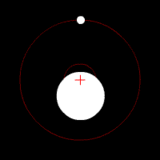The distances between two stars in a binary system can vary greatly.
Two stars can orbit each other with a separation only a few times as great as their diameters.
In fact, two stars can be so close together that they actually touch each other.
https://en.wikipedia.org/wiki/Contact_binary[1]
Other stars orbit each other at vast distances. The system of HD134439 and HD134440 has a separation of about half a light year between the two stars.
https://en.wikipedia.org/wiki/HD_134439/HD_134440[2]
And the separations of other binary stars vary between those two extremes.
A planet in a binary star system can either orbit one of the stars in an S-type orbit or orbit both of the stars in a circumbinary or P-type orbit.
https://en.wikipedia.org/wiki/Habitability_of_binary_star_systems[3]
The closer the two stars are to each other, the more likely it is that any planets in the system will orbit both of the stars in P-type orbits. The farther the two stars are apart, the more likely it is that planets will orbit either one star or separately around each of the stars in S-type orbits.
It is perfectly possible as far as orbital dynamics are concerned to have a binary system where there are planets in close S-type orbits around each of the stars and other planets in distant P-type orbits around both of the stars.
Each star, or close binary pair of stars, has a circumstellar habitable zone around it where the temperatures of orbiting planets would permit surface water to be liquid.
https://en.wikipedia.org/wiki/Circumstellar_habitable_zone[4]
Because of the narrowness of circumstellar habitable zones, there very probably could not be habitable planets in both the S-type orbits and the P-type orbits. So writers of stories with one or more habitable planets in a binary system have to choose whether those planets orbit one of the stars in S-type orbits and the other star is much more distant than the planets, or the planets orbit both of the stars in P-type orbits several times as far away as the stars are from each other.
If two stars in a binary system appear to have the same angular diameter as seen from a planet, either they have the same physical diameter, and are the same distance wawy, making the planet have a P-type orbit around both, or have greatly different diameters, with the smaller star being closer to the planet, close enough to appear as large as the farther star, thus making the planet have to orbit the smaller star in an S-type orbit.
Of course the two stars do not need to have the same apparent diameter as seen from their lanets, whether those planets are in S-type orbits around one star or P-type aorbits around both stars.
There are many binary or multiple star systems where the stars are separated by such vast distances that from a planet orbiting one star the other star would appear as a dimensionless dot of light, a very bright star, instead of like a sun with a visible disc.
There are limitations on the types of stars which can be within a system with habitable planets. Most binary or multiple star systems have stars of the same age because they formed together. Only a tiny minority of binary or multiple star systems should contain stars of greatly different age which happened to capture each other long after they formed.
More massives stars have more nuclear fuel, but they have to consume that fuel much faster. The increase in the rate at which fuel is burned is much greater than the increase in fuel reserves, so more massive stars use up their fuel sooner than less massive stars.
A star needs to shine relatively steadily in the main sequence stage of its development for billions of years in order for a planet with life to develop conditions - such as an oxygen rich atmosphere - suitable for the survival of humans or other beings with similar environmental requirements.
Stars which have passed out of the main sequence stages of their development - stars such as red giants and supergiants, white dwarfs, neutron stars, and black holes - are likely to have damaged, and possibly totally destroyed, any once habitable planets which once orbited them. And if those stars are close enough to other stars in their systems they might have damaged and even totally destroyed any planets which orbited those other stars in the system.
And there are other requirements for stars to have habitable planets. Unless a writer writes about a dead and lifeless planet, or one with only primitive lifeforms and no large plants or animals, or one where life has a totally alien biochemistry, they need to limit the types of stars in their fictional star system to types of stars compatible with planets habitable for humans and beings with similar requirements.
So a writer of stories set on planets of other stars should seek out and read Habitable Planets for Man, Stephen H. Dole, 1964, 2007 to study the various requirements, including stellar type, for a habitable planet.
https://www.rand.org/content/dam/rand/pubs/commercial_books/2007/RAND_CB179-1.pdf[5]



